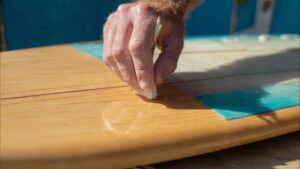Best Surfboard Wax Remover Hacks to Keep Your Board Fresh

Surfing is all about the thrill of the waves, but a waxy, grimy surfboard can slow you down and ruin your ride. Keeping your board clean with effective surfboard wax remover techniques is essential for maintaining performance and extending its lifespan. At Cool Surfing Gear, you’ll find tips, tools, and products to keep your surfboard in top shape. Whether you’re a seasoned surfer or a beginner, removing old wax buildup is a must to ensure your board stays grippy and ready for action. This article shares the best surfboard wax remover hacks to keep your board fresh, clean, and primed for the waves.
Why Removing Surfboard Wax Matters

Old surfboard wax can become dirty, sticky, and less effective over time. Sand, dust, and saltwater cling to it, creating a gritty surface that reduces traction. Additionally, wax can harden in cold weather or melt in the sun, making your board slippery or uneven. Regularly removing wax keeps your board’s surface smooth, improves grip, and prepares it for a fresh coat. A clean board also looks better and performs better, giving you more control on the waves.
For a step-by-step guide on how to remove surfboard wax, you can find expert tips to simplify the process. By staying proactive, you prevent buildup that could damage your board’s finish or affect its hydrodynamics. Let’s dive into the best methods to get that wax off efficiently.
Top Surfboard Wax Remover Hacks
Use Warmth to Soften the Wax
Heat is your best friend when tackling stubborn surfboard wax. Leaving your board in the sun for 10-15 minutes softens the wax, making it easier to scrape off. Alternatively, use a hairdryer on a low setting to warm the surface. Hold it about six inches away and move it evenly across the board. Once the wax is soft, use a plastic scraper or an old credit card to gently lift it off. This method is quick, effective, and requires minimal tools.
However, be cautious not to overheat the board, as excessive heat can damage the fiberglass or epoxy. Always test a small area first. This hack works well for most wax types and is a great starting point for any cleaning session.
Try a Citrus-Based Cleaner
Citrus-based cleaners are a game-changer for surfboard wax removal. These eco-friendly products break down wax without harming your board’s finish. Brands like Pickle Wax Remover or Sticky Bumps offer citrus-based solutions that dissolve wax residue effectively. Apply the cleaner to a soft cloth, rub it over the waxed areas, and wipe clean. The citrus oils cut through grease and leave a pleasant scent.
Additionally, these cleaners are biodegradable, making them a sustainable choice. According to Surfer Magazine, citrus cleaners are a favorite among eco-conscious surfers for their effectiveness and environmental benefits. Always follow up with a freshwater rinse to remove any remaining residue.
Household Items That Work Wonders
You don’t always need fancy products to remove surfboard wax. Common household items can do the trick. For example, white vinegar mixed with warm water (1:1 ratio) can loosen wax when applied with a cloth. Rub gently, then scrape off the softened wax. Another option is rubbing alcohol, which dissolves wax quickly but should be used sparingly to avoid drying out the board’s surface.
Baking soda mixed with water into a paste can also tackle stubborn spots. Apply the paste, let it sit for a few minutes, and scrub with a soft sponge. These household hacks are budget-friendly and accessible, perfect for surfers who want to save money while keeping their boards clean.
Use a Wax Comb for Precision
A wax comb is a must-have tool for any surfer. Its serrated edge is designed to scrape wax efficiently, while the smooth side helps polish the board. Start by scraping off large chunks of wax with the serrated edge, working in small sections. Then, use the smooth side to buff out any remaining residue. This method is ideal for spot-cleaning or removing wax from specific areas, like the nose or tail of the board.
For best results, combine the wax comb with a citrus cleaner or warm water to loosen the wax first. This approach ensures a thorough clean without scratching your board. Wax combs are affordable and widely available at surf shops or online.
Hot Water and a Towel for Quick Fixes
If you’re in a pinch, hot water and a towel can work as a simple surfboard wax remover. Pour warm (not boiling) water over the waxed areas to soften the wax. Then, use a soft towel to wipe it away. This method is gentle and won’t harm your board’s finish, but it may require more effort for thick wax buildup. It’s best for light wax layers or quick cleanups between sessions.
To enhance this hack, add a drop of dish soap to the warm water. The soap helps break down the wax’s oils, making it easier to remove. Rinse the board thoroughly afterward to prevent soap residue from affecting your next wax application.
Tips to Prevent Wax Buildup
Prevention is key to reducing the need for frequent wax removal. Here are some practical tips to keep your board in top condition:
- Apply Wax Sparingly: Use thin, even layers when waxing to avoid excessive buildup.
- Choose the Right Wax: Select wax suited for your local water temperature (e.g., cold-water wax for cooler climates).
- Store Properly: Keep your board in a cool, shaded place to prevent wax from melting or hardening.
- Clean Regularly: Remove old wax every few months or when it starts looking dirty.
By following these tips, you’ll spend less time scrubbing and more time surfing. Consistent maintenance also protects your board’s performance and appearance.
Eco-Friendly Surfboard Wax Removal
Sustainability matters in surfing, and eco-friendly wax removal methods are gaining popularity. Besides citrus-based cleaners, you can use natural alternatives like coconut oil to break down wax. Apply a small amount to the board, let it sit for a few minutes, and wipe it off with a cloth. Coconut oil is gentle, biodegradable, and safe for most board materials.
Another green option is to reuse old wax. Scrape off large chunks, melt them down, and strain out debris to create a reusable wax block. This reduces waste and saves money. According to The Inertia, sustainable practices like these are becoming a priority for surfers worldwide.
Read More Also: How Do You Describe a Marriage Ceremony?
Conclusion
Keeping your surfboard clean with effective surfboard wax remover hacks is essential for optimal performance and longevity. From using heat and citrus cleaners to household items and wax combs, these methods make wax removal simple and efficient. By incorporating eco-friendly practices and preventive tips, you can maintain a fresh, grippy board while minimizing environmental impact. Regular cleaning ensures your board is always ready for the waves, giving you the confidence to surf your best. Try these hacks today and enjoy a smoother, cleaner ride.
Read More Also: Five Most Affordable Countries To Study Abroad
Frequently Asked Questions
What is the easiest way to remove surfboard wax?
The easiest method is to soften the wax with heat (sun or hairdryer) and scrape it off with a plastic scraper or wax comb, followed by a citrus-based cleaner for residue.
Can I use household items as a surfboard wax remover?
Yes, items like white vinegar, rubbing alcohol, or baking soda paste can effectively remove wax. Always rinse the board afterward to avoid residue buildup.
How often should I remove wax from my surfboard?
Remove wax every 2-3 months or when it becomes dirty or loses grip. Regular cleaning prevents buildup and maintains performance.
Are citrus-based cleaners safe for all surfboards?
Citrus-based cleaners are safe for most fiberglass and epoxy boards. Test a small area first and rinse thoroughly to avoid damage.
How can I prevent excessive wax buildup?
Apply thin layers of wax, use temperature-appropriate wax, store your board properly, and clean it regularly to minimize buildup.







